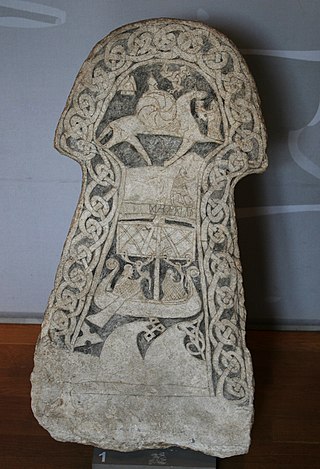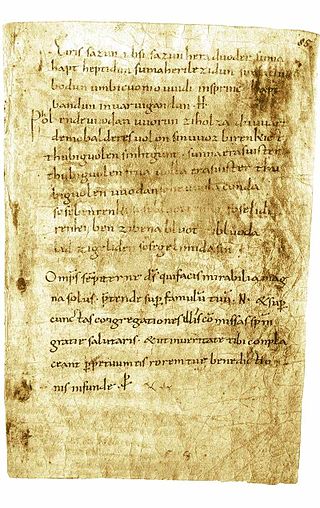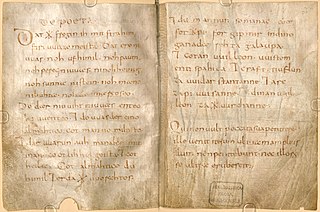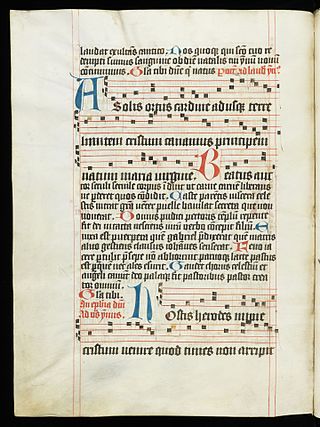
Mass is the main Eucharistic liturgical service in many forms of Western Christianity. The term Mass is commonly used in the Catholic Church, Western Rite Orthodoxy, Old Catholicism, and Independent Catholicism. The term is also used in some Lutheran churches, as well as in some Anglican churches, and on rare occasion by other Protestant churches.

In Norse mythology, a valkyrie is one of a host of female figures who guide souls of the dead to the god Odin's hall Valhalla. There, the deceased warriors become einherjar. When the einherjar are not preparing for the events of Ragnarök, the valkyries bear them mead. Valkyries also appear as lovers of heroes and other mortals, where they are sometimes described as the daughters of royalty, sometimes accompanied by ravens and sometimes connected to swans or horses.

Cædmon is the earliest English poet whose name is known. A Northumbrian cowherd who cared for the animals at the double monastery of Streonæshalch during the abbacy of St. Hilda, he was originally ignorant of "the art of song" but learned to compose one night in the course of a dream, according to the 8th-century historian Bede. He later became a zealous monk and an accomplished and inspirational Christian poet.

The Angelus is a Catholic devotion commemorating the Incarnation of Christ. As with many Catholic prayers, the name Angelus is derived from its incipit—the first few words of the text: Angelus Domini nuntiavit Mariæ. The devotion is practised by reciting as versicle and response three Biblical verses narrating the mystery, alternating with the prayer "Hail Mary". The Angelus exemplifies a species of prayers called the "prayer of the devotee".
In the Western Church of the Early and High Middle Ages, a sacramentary was a book used for liturgical services and the mass by a bishop or priest. Sacramentaries include only the words spoken or sung by him, unlike the missals of later centuries that include all the texts of the mass whether read by the bishop, priest, or others. Also, sacramentaries, unlike missals, include texts for services other than the mass such as ordinations, the consecration of a church or altar, exorcisms, and blessings, all of which were later included in Pontificals and Rituals instead.
Northumbrian was a dialect of Old English spoken in the Anglian Kingdom of Northumbria. Together with Mercian, Kentish and West Saxon, it forms one of the sub-categories of Old English devised and employed by modern scholars.

A mare is a malicious entity in Germanic and Slavic folklore that rides on people's chests while they sleep, bringing on nightmares.

Anglo-Saxon paganism, sometimes termed Anglo-Saxon heathenism, Anglo-Saxon pre-Christian religion, or Anglo-Saxon traditional religion, refers to the religious beliefs and practices followed by the Anglo-Saxons between the 5th and 8th centuries AD, during the initial period of Early Medieval England. A variant of Germanic paganism found across much of north-western Europe, it encompassed a heterogeneous variety of beliefs and cultic practices, with much regional variation.

The Merseburg charms or Merseburg incantations are two medieval magic spells, charms or incantations, written in Old High German. They are the only known examples of Germanic pagan belief preserved in the language. They were discovered in 1841 by Georg Waitz, who found them in a theological manuscript from Fulda, written in the 9th century, although there remains some speculation about the date of the charms themselves. The manuscript is stored in the library of the cathedral chapter of Merseburg, hence the name.

The Wessobrunn Prayer is among the earliest known poetic works in Old High German, believed to date from the end of the 8th century.
The Sacrament of Penance is one of the seven sacraments of the Catholic Church, in which the faithful are absolved from sins committed after baptism and reconciled with the Christian community. During reconciliation mortal sins must be confessed and venial sins may be confessed for devotional reasons. According to the dogma and unchanging practice of the church, only those ordained as priests may grant absolution.

Odin is a widely revered god in Germanic paganism. Norse mythology, the source of most surviving information about him, associates him with wisdom, healing, death, royalty, the gallows, knowledge, war, battle, victory, sorcery, poetry, frenzy, and the runic alphabet, and depicts him as the husband of the goddess Frigg. In wider Germanic mythology and paganism, the god was also known in Old English as Wōden, in Old Saxon as Uuôden, in Old Dutch as Wuodan, in Old Frisian as Wêda, and in Old High German as Wuotan, all ultimately stemming from the Proto-Germanic theonym *Wōðanaz, meaning 'lord of frenzy', or 'leader of the possessed'.
"For a Swarm of Bees" is an Anglo-Saxon metrical charm that was intended for use in keeping honey bees from swarming. The text was discovered by John Mitchell Kemble in the 19th century. The charm is named for its opening words, "wiþ ymbe", meaning "against a swarm of bees".
Anglo-Saxon metrical charms were sets of instructions generally written to magically resolve a situation or disease. Usually, these charms involve some sort of physical action, including making a medical potion, repeating a certain set of words, or writing a specific set of words on an object. These Anglo-Saxon charms tell a great deal about medieval medical theory and practice. Although most medical texts found from the pre-Christian Anglo-Saxon period are translations of Classical texts in Latin, these charms were originally written in Old English.

Napoleon was crowned Emperor of the French on Sunday, December 2, 1804, at Notre-Dame de Paris in Paris. It marked "the instantiation of [the] modern empire" and was a "transparently masterminded piece of modern propaganda".

Christ treading on the beasts is a subject found in Late Antique and Early Medieval art, though it is never common. It is a variant of the "Christ in Triumph" subject of the resurrected Christ, and shows a standing Christ with his feet on animals, often holding a cross-staff which may have a spear-head at the bottom of its shaft, or a staff or spear with a cross-motif on a pennon. Some art historians argue that the subject exists in an even rarer pacific form as "Christ recognised by the beasts".

"A solis ortus cardine..." is a poem by Coelius Sedulius, recounting Christ's life from his birth to his resurrection. Its 23 verses each begin with a consecutive letter of the Latin alphabet, making the poem an abecedarius. It is one of the oldest parts of the Roman Catholic liturgy, with two hymns formed from the first seven and four later verses. There have been monastic translations into Anglo-Saxon and later translations into other languages, most notably the German versification of Martin Luther during the Reformation. The original Latin hymn and Luther's translation have been set for chorus and organ by many composers including Dufay, di Lasso, Praetorius, Palestrina, Scheidt, de Grigny and Bach.
The Lorsch riddles, also known as the Aenigmata Anglica, are a collection of twelve hexametrical, early medieval Latin riddles that were anonymously written in the ninth century.

Blessing of animals can be either of the animal or of the human-animal relationship, and can apply to pets and other companion animals, or to agricultural animals and working and other animals which humans depend on or interact with.














